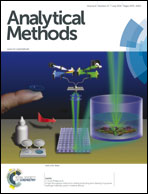A universal glucometer-based biosensor for portable and quantitative detection of transcription factors†
Abstract
A universal biosensor for the portable and quantitative detection of transcription factors has been constructed using a commercially available glucometer as the sensing platform. With the specific protein-binding DNA and antibody as the recognition elements, invertase as the linker, and glucometer as the transducer, quantitative detection was achieved via target-induced capturing of invertase conjugates on magnetic beads, thereby transforming the concentration of the target in the sample into glucose through invertase-catalyzed hydrolysis of sucrose. In comparison with laboratory-based instruments or customized devices, the glucometer-based biosensor has the significant advantages of low cost, compact size, wide accessibility, and ease of use, making it as convenient for use at home as in the field. As a proof of concept, Oct4, an important transcription factor for the regulation of the process of embryonic stem cells differentiation, was used as the model target. Using the proposed point-of-care strategy, Oct4 can be quantified in the range from 0.05 to 25 ng mL−1 with a detection limit of 0.05 ng mL−1, which is comparable to the commercial Oct4 test kits. The glucometer-based biosensor is robust and can be used directly to measure the transcription factor activities in crude cell lysate with excellent selectivity. It is expected that this assay principle can be directed towards other DNA-binding transcription factors by simply changing the binding site sequence and the corresponding antibody.


 Please wait while we load your content...
Please wait while we load your content...